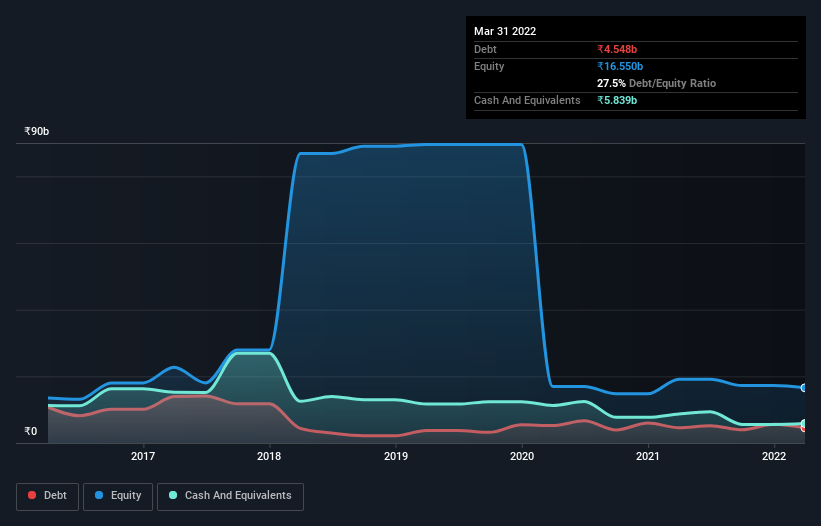- India
- /
- Hospitality
- /
- NSEI:THOMASCOOK
Thomas Cook (India) (NSE:THOMASCOOK) Has Debt But No Earnings; Should You Worry?

Some say volatility, rather than debt, is the best way to think about risk as an investor, but Warren Buffett famously said that 'Volatility is far from synonymous with risk.' When we think about how risky a company is, we always like to look at its use of debt, since debt overload can lead to ruin. We can see that Thomas Cook (India) Limited (NSE:THOMASCOOK) does use debt in its business. But is this debt a concern to shareholders?
When Is Debt A Problem?
Debt and other liabilities become risky for a business when it cannot easily fulfill those obligations, either with free cash flow or by raising capital at an attractive price. In the worst case scenario, a company can go bankrupt if it cannot pay its creditors. However, a more common (but still painful) scenario is that it has to raise new equity capital at a low price, thus permanently diluting shareholders. Of course, debt can be an important tool in businesses, particularly capital heavy businesses. The first step when considering a company's debt levels is to consider its cash and debt together.
See our latest analysis for Thomas Cook (India)
How Much Debt Does Thomas Cook (India) Carry?
As you can see below, Thomas Cook (India) had ₹4.55b of debt, at March 2022, which is about the same as the year before. You can click the chart for greater detail. But on the other hand it also has ₹5.84b in cash, leading to a ₹1.29b net cash position.

How Healthy Is Thomas Cook (India)'s Balance Sheet?
Zooming in on the latest balance sheet data, we can see that Thomas Cook (India) had liabilities of ₹19.8b due within 12 months and liabilities of ₹10.1b due beyond that. On the other hand, it had cash of ₹5.84b and ₹2.35b worth of receivables due within a year. So its liabilities total ₹21.7b more than the combination of its cash and short-term receivables.
This deficit is considerable relative to its market capitalization of ₹31.6b, so it does suggest shareholders should keep an eye on Thomas Cook (India)'s use of debt. Should its lenders demand that it shore up the balance sheet, shareholders would likely face severe dilution. Despite its noteworthy liabilities, Thomas Cook (India) boasts net cash, so it's fair to say it does not have a heavy debt load! The balance sheet is clearly the area to focus on when you are analysing debt. But it is Thomas Cook (India)'s earnings that will influence how the balance sheet holds up in the future. So if you're keen to discover more about its earnings, it might be worth checking out this graph of its long term earnings trend.
Over 12 months, Thomas Cook (India) reported revenue of ₹19b, which is a gain of 137%, although it did not report any earnings before interest and tax. So its pretty obvious shareholders are hoping for more growth!
So How Risky Is Thomas Cook (India)?
By their very nature companies that are losing money are more risky than those with a long history of profitability. And the fact is that over the last twelve months Thomas Cook (India) lost money at the earnings before interest and tax (EBIT) line. Indeed, in that time it burnt through ₹2.3b of cash and made a loss of ₹2.3b. With only ₹1.29b on the balance sheet, it would appear that its going to need to raise capital again soon. Importantly, Thomas Cook (India)'s revenue growth is hot to trot. While unprofitable companies can be risky, they can also grow hard and fast in those pre-profit years. The balance sheet is clearly the area to focus on when you are analysing debt. But ultimately, every company can contain risks that exist outside of the balance sheet. Be aware that Thomas Cook (India) is showing 2 warning signs in our investment analysis , and 1 of those is a bit unpleasant...
If you're interested in investing in businesses that can grow profits without the burden of debt, then check out this free list of growing businesses that have net cash on the balance sheet.
Valuation is complex, but we're here to simplify it.
Discover if Thomas Cook (India) might be undervalued or overvalued with our detailed analysis, featuring fair value estimates, potential risks, dividends, insider trades, and its financial condition.
Access Free AnalysisHave feedback on this article? Concerned about the content? Get in touch with us directly. Alternatively, email editorial-team (at) simplywallst.com.
This article by Simply Wall St is general in nature. We provide commentary based on historical data and analyst forecasts only using an unbiased methodology and our articles are not intended to be financial advice. It does not constitute a recommendation to buy or sell any stock, and does not take account of your objectives, or your financial situation. We aim to bring you long-term focused analysis driven by fundamental data. Note that our analysis may not factor in the latest price-sensitive company announcements or qualitative material. Simply Wall St has no position in any stocks mentioned.
About NSEI:THOMASCOOK
Thomas Cook (India)
Offers integrated travel services in India and internationally.
Undervalued with reasonable growth potential.
Similar Companies
Market Insights
Community Narratives



